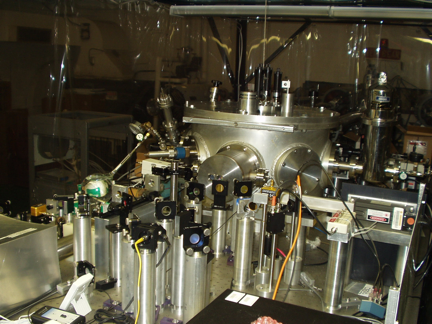
Simplified schematic of fast-beam co-linear laser spectroscopy set-up for helium-like silicon. The super-mirrors form the high-finesse build-up cavity.

Laser-ion beam interaction chamber containing ultra-high-finesse laser power build-up cavity. The ion beam enters from the far side.
Laser Spectroscopy of Highly-Charged Ions
Our Techniques - Lasers combined with an accelerator
Our measurements use the fast-ion-beam laser technique. The highly-charged ions are produced by passing accelerated, less highly-charged ions through a thin carbon foil. The fast ions are obtained from the Florida State Van de Graaff accelerator at the J.D. Fox Nuclear Physics Lab at FSU. The ions typically move at 5% of the speed of light. This results in very short ion-laser interaction times and large Doppler shifts. To help overcome these problems we have developed techniques for co-linear laser spectroscopy. We have also used two lasers, at different frequencies, to interact with the ions in co- and counter-propagating geometry. For measurements on nitrogen, fluorine and magnesium we modified a high power (400W) industrial cw CO2 laser to make it line tunable, and to obtain kW circulating powers for intra-cavity spectroscopy. For silicon, we have developed a dual-frequency, ultra-high-finesse, optical build-up cavity. This is coupled to a diode-pumped cw Nd-YAG laser, and a homemade, two-stage, fiber-Bragg-grating stabilized diode laser. With this system we achieved over 1 kW cw laser power at the interaction region. These high powers are needed to observe the weak magnetic dipole, or first-order-forbidden electric-dipole transitions in the fast ions. Sensitivity to the weak infra-red transitions is also enhanced by detecting UV or X-ray fluorescence. The current fast-beam laser spectroscopy set-up is mounted on a 16ft x 5 ft laser table, and connected to a dedicated beamline of the FSU Tandem Van de Graaff accelerator.
An alternative method for producing few-electron ions is to use an intense electron beam to ionize a cloud of ions trapped in an Electron Beam Ion Trap (EBIT). We have collaborated with the Oxford EBIT group in laser spectroscopy of ions in an EBIT. Using a special 14CO2 laser we succeeded in measuring the 2s1/2 - 2p3/2 transition in N6+. To our knowledge this was the first laser spectroscopy of trapped few-electron ions in an EBIT.
